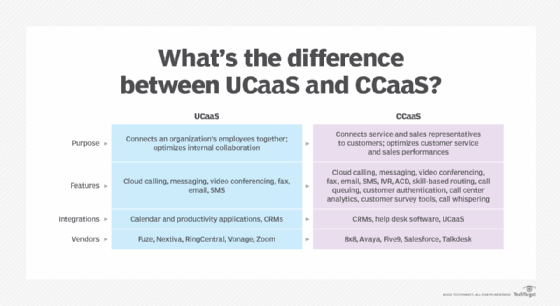
Getty Images
UCaaS vs. CCaaS: What's the difference?
UCaaS and CCaaS feature overlapping communication channels, such as cloud calling and messaging, but CCaaS comes with additional tools that can support a contact center.
Although UCaaS and CCaaS are both cloud-based communication platforms, UCaaS focuses on internal interactions whereas CCaaS focuses on external interactions.
Cloud services, such as unified communications as a service (UCaaS) and contact center as a service (CCaaS), became popular alternatives to on-premises systems in the mid-2010s and saw increased adoption amid the COVID-19 pandemic. While both technologies embed various communication channels into one interface, they serve different purposes. UCaaS generally connects an organization's employees to each other, and CCaaS connects sales and service representatives to customers.
Organizations can integrate UCaaS and CCaaS, but they are distinct platforms. Technology buyers should understand each service's features to ensure they buy the right platform for their needs.
What is UCaaS?
UCaaS is a cloud-based platform that integrates various communications channels, such as cloud calling, messaging and video conferencing, into one interface. Organizations typically purchase UCaaS software to streamline communication and collaboration among employees.
UCaaS users typically pay lower upfront costs than companies with on-premises unified communications systems, as they don't need to purchase hardware. UCaaS also supports remote work, and users can access the software from any location.
What is CCaaS?
CCaaS is a cloud-based platform that integrates communication channels and contact center tools, such as advanced analytics and interactive voice response (IVR), into one interface. This service can enhance inbound and outbound communication between customers and contact center agents. Organizations generally invest in CCaaS to improve CX and boost sales performances.
Vendors cover hardware and maintenance expenses, so CCaaS offers users lower upfront and overhead costs than on-premises contact centers. CCaaS also supports remote work, because contact center agents can access the platform from anywhere.
What are the differences between UCaaS and CCaaS?
While UCaaS and CCaaS are both cloud-based platforms that integrate communication tools, the two services differ in purpose, features, integrations and vendors.
Purpose. UCaaS connects an organization's employees to each other, while CCaaS connects customer service and sales representatives to the company's customers. Organizations may purchase UCaaS to replace existing private branch exchange phone systems, as UCaaS offers more channels than just cloud calling. UCaaS can also streamline interorganizational communications into one interface and enable remote collaboration. Typically, an organization's IT department oversees UCaaS implementation.
CCaaS, on the other hand, helps organizations provide quality customer interactions. Organizations with high inbound and outbound call volumes may purchase CCaaS to streamline customer service and sales communication channels. Organizations that need to support a remote contact center or sales team may consider CCaaS, as well. Service and sales leaders typically oversee CCaaS implementation.
Features. UCaaS and CCaaS both include call routing. However, CCaaS has additional features, including:
- IVR systems,
- automated call distributors,
- skill-based routing,
- call queuing,
- customer authentication,
- call center analytics,
- customer survey tools and
- call whispering.
These additional CCaaS features help contact centers manage high call volumes and provide quality assurance for customer service interactions.
Integrations. Organizations commonly integrate UCaaS software with productivity and calendar applications. Calendar integrations enable employees to schedule meetings with each other. UCaaS integrations with productivity apps, such as DocuSign, can improve workflows.
Organizations typically integrate their CCaaS platforms with a CRM. As CCaaS enables representatives to interact with customers, a CRM can track each interaction. Organizations can also integrate CCaaS with help desk tools and UCaaS platforms. Integrated UCaaS and CCaaS software helps agents contact subject matter experts within their organization, which can reduce problem resolution time.
Vendors. Leading UCaaS vendors include Fuze -- an 8x8 company -- Nextiva, RingCentral, Vonage and Zoom. Leading CCaaS vendors include 8x8, Avaya, Five9, Salesforce and Talkdesk.

Similarities between UCaaS and CCaaS
Despite their differences, UCaaS and CCaaS platforms follow a cloud-based payment model and feature streamlined communications. Additionally, they both can include call routing, which can integrate with CRMs and other apps.
UCaaS and CCaaS platforms also have vendors in common, as the markets have begun to merge. For instance, many UCaaS vendors, such as Nextiva and Vonage, have CCaaS offerings that let users purchase a platform with both UCaaS and CCaaS features.
UCaaS and CCaaS pros and cons
As cloud-based platforms, UCaaS and CCaaS have advantages over on-premises systems, including the following.
- Easy installation and maintenance. Adopters don't need to pay for hardware or software installation and maintenance.
- Remote-friendly. Employees can access cloud-based platforms from any location or device.
- Simplicity. UCaaS and CCaaS platforms embed various tools into one interface.
- Easy integration. Organizations can easily integrate their platforms with apps from other vendors.
- Scalability. Organizations can upgrade or downgrade their service packages to match their immediate needs.
However, an organization that switches to a cloud service from an on-premises system may encounter drawbacks, such as the following.
- Resistance to change. When organizations switch from on-premises to cloud systems, user adoption may come slowly.
- Training. For users accustomed to legacy systems, UCaaS or CCaaS tools may be unfamiliar and require training.
- Incompatibility with on-premises software. Although organizations can integrate UCaaS and CCaaS platforms with many modern apps, integration with older software may be difficult or impossible.
- Cost. The cloud-based delivery model offers low upfront costs, but in the long term may cost more than an on-premises system.
Technology buyers should consider their specific goals before purchasing a UCaaS or CCaaS platform, so they choose a platform that matches their needs. A standard UCaaS platform can boost internal collaboration with its streamlined communications, while CCaaS includes additional tools that support a full-scale contact center.






